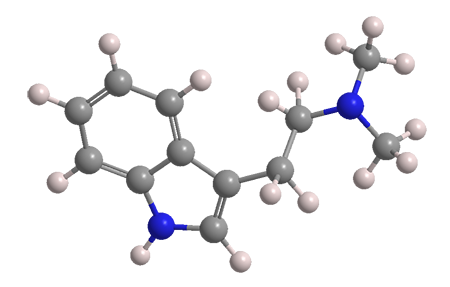What molecule am I?


N,N-Dimethyltryptamine (DMT) is a plant-based hallucinogen that is outlawed in most countries. DMT was isolated from many species in the 1950s, notably by Pfizer chemists F. A. Hochstein and Anita M. Paradies, who discovered it in the leaves of Prestonia amazonica (aka Haemadictyon amazonicum), which is called “yagé” by inhabitants of the Peruvian Amazon basin.
Hungarian chemist/psychologist Stephen Szará synthesized DMT in 1956 and studied its psychotropic effects in volunteers during that decade. DMT is sometimes called the “spirit molecule”; it produces psychedelic results when it is swallowed, inhaled, injected, or “vaped”. The DMT structure with a hydroxyl group on the benzene ring is the “feel-good” molecule serotonin.
DMT is currently an outlaw, but chemist David Olson and his research team at the University of California, Davis, may have found a legitimate pharmaceutical use for it and other hallucinogens. In an effort to find alternatives to the side effect–prone anesthetic ketamine* for treating depression, the investigators showed that DMT, LSD, and other psychotropics increase the number of synapses in the brain areas of lab animals that regulate emotion and mood.
As with ketamine, the effects are long-lasting and involve a similar signaling pathway. These results are promising, but any commercial drug to arise from them is a long way off.
*Recently reported research indicates that ketamine may require signaling through opioid receptors.
N,N-Dimethyltryptamine hazard information
| GHS classification**: acute toxicity, oral, category 3 | |
| H301—Toxic if swallowed | |
**Globally Harmonized System of Classification and Labeling of Chemicals. Explanation of pictograms.
N,N-Dimethyltryptamine fast facts
| CAS Reg. No. | 61-50-7 |
| Molar mass | 188.27 g/mol |
| Empirical formula | C12H16N2 |
| Appearance | Clear or white crystals |
| Melting point | 46 ºC |
| Water solubility | Extremely low |
MOTW update: March 11, 2019
N,N-Dimethyltryptamine (DMT) is a plant-based hallucinogen that is outlawed in most countries; but researchers are exploring its possible use as an antidepression drug. Now, David E. Olson at the University of California, Davis, and colleagues at several institutions report that “chronic, intermittent, low doses of DMT produced an antidepressant-like phenotype and enhanced fear extinction learning without impacting working memory or social interaction” in lab rats. Unfortunately, the rats also gained significant amounts of body weight. Their research continues.

Learn more about this molecule from CAS, the most authoritative and comprehensive source for chemical information.
Molecule of the Week needs your suggestions!
If your favorite molecule is not in our archive, please send us a message. The molecule can be notable for its current or historical importance or for any quirky reason. Thank you!
Stay Ahead of the Chemistry Curve
Learn how ACS can help you stay ahead in the world of chemistry.

